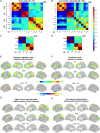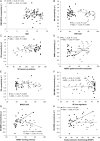Patterns of Atypical Functional Connectivity and Behavioral Links in Autism Differ Between Default, Salience, and Executive Networks
- PMID: 26351318
- PMCID: PMC5027998
- DOI: 10.1093/cercor/bhv191
Patterns of Atypical Functional Connectivity and Behavioral Links in Autism Differ Between Default, Salience, and Executive Networks
Abstract
Autism spectrum disorder (ASD) is characterized by atypical brain network organization, but findings have been inconsistent. While methodological and maturational factors have been considered, the network specificity of connectivity abnormalities remains incompletely understood. We investigated intrinsic functional connectivity (iFC) for four "core" functional networks-default-mode (DMN), salience (SN), and left (lECN) and right executive control (rECN). Resting-state functional MRI data from 75 children and adolescents (37 ASD, 38 typically developing [TD]) were included. Functional connectivity within and between networks was analyzed for regions of interest (ROIs) and whole brain, compared between groups, and correlated with behavioral scores. ROI analyses showed overconnectivity (ASD > TD), especially between DMN and ECN. Whole-brain results were mixed. While predominant overconnectivity was found for DMN (posterior cingulate seed) and rECN (right inferior parietal seed), predominant underconnectivity was found for SN (right anterior insula seed) and lECN (left inferior parietal seed). In the ASD group, reduced SN integrity was associated with sensory and sociocommunicative symptoms. In conclusion, atypical connectivity in ASD is network-specific, ranging from extensive overconnectivity (DMN, rECN) to extensive underconnectivity (SN, lECN). Links between iFC and behavior differed between groups. Core symptomatology in the ASD group was predominantly related to connectivity within the salience network.
Keywords: autism spectrum disorder; default-mode network; executive control network; functional connectivity; salience network.
© The Author 2015. Published by Oxford University Press. All rights reserved. For Permissions, please e-mail: journals.permissions@oup.com.
Figures


References
-
- Alaerts K, Nayar K, Kelly C, Raithel J, Milham MP, Di Martino A. 2015. Age-related changes in intrinsic function of the superior temporal sulcus in autism spectrum disorders. Soc Cogn Affect Neurosci. doi:10.1093/scan/nsv029. - DOI - PMC - PubMed
-
- Allen G, Courchesne E. 2001. Attention function and dysfunction in autism. Front Biosci. 6:D105–D119. - PubMed
-
- American Psychiatric Association. 2000. Diagnostic and statistical manual of mental disorders-IV-TR. Washington: (DC: ): American Psychiatric Association.
Publication types
MeSH terms
Grants and funding
LinkOut - more resources
Full Text Sources
Other Literature Sources
Medical

